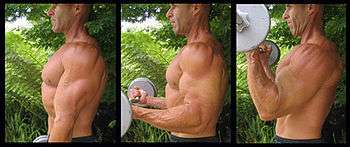Biceps curl

The term "biceps curl" may refer to any of a number of weight training exercises that target the biceps brachii muscle.
Overview

Although the exercises differ, a common factor of each is a 'curling' motion, where a weight (attached to, or used in conjunction with, an item of equipment listed above) is lifted up until the forearms are vertical[1] with the elbows and upper arm remaining close to the body.[2]
The fullest range of motion is when the elbows begin in full extension, in a supine grip. The biceps contract to lift the weight upward through an arc, to a point where further movement is not possible. Some lifters also do partial reps (such as in "21s") focusing on the top or bottom position. The second part of the motion has the elbow joint extending, this is called the 'eccentric' portion. The weight is lowered back to the start position.

Some think it is important that the elbow remain next to the body during this motion to keep stress on the biceps. Others will either bring the elbows forward (to fully shorten the biceps)[3] or bring the elbows back (a "drag curl", to avoid over-active insufficiency and keep parallel forearms)[4] to vary the tensions placed on the biceps and other elbow flexors. A research found that the preacher curl targets the long head of the biceps significantly only when the arm was almost full extended and the range of motion was short. On the other hand, the incline dumbbell curl and the regular biceps curl activated the biceps brachii throughout the entire range of motion and may be preferable in improving the biceps strength.[5]
This contraction and extension together constitute a single repetition. As with most weight training exercises, results from biceps exercises can be maximized with a proper understanding of flexion.
The barbell curl specifically targets the biceps brachii which is located on the front part of the arm between the shoulder and the elbow. This muscle's primary function is elbow flexion and forearm supination. The biceps also has two heads known as the long head and the short head.[6]
Variations
Several variations on the biceps curl transfer some of the load from the biceps to other flexors of the elbow, thus enabling a person to use bigger weights without causing an injury.
Extended shoulder
- supine-body incline curl: With an adjustable bench positioned at a 45 degree angle, one could perform incline biceps curls . Incline biceps curls are usually performed with dumbbells in each hand, and by sitting on the incline bench, holding the dumbbells close to the body with elbows tucked in, and performing a full curl.[7]
Flexed shoulder
One group of variations involves postures that hold the elbows in front of the trunk, shortening the biceps and forcing the brachialis to do more work. Variations on this theme include:
- concentration curl where the elbow is braced against the inside of the knee[8]
- preacher curl where the elbows rest upon a sloped bench[9]
- prone-body incline curl performed lying prone on an inclined bench, where the force of gravity holds the upper arms in front of the trunk.[10]
- spider curl which uses the preacher bench but uses the other side, so curling is done at a 90 degree angle. This position is similar to the prone-body incline curl except that the preacher bench restricts the movement of the upper arm.
Drag curl
This variation involves moving the elbows back as they are flexed. As the weight is raised, they are moved forward. This variation allows a relative release of tension in muscles between repetitions.[11]
Grip variations
The biceps curl is usually performed with the palms supinated (facing upwards). Turning the palms inward transfers load from the biceps to the brachioradialis. Variations on this concept include the hammer curl, performed with the palm inward, neither pronated nor supinated,[12] and the reverse curl, with the palms pronated (facing downwards).[13]
References
- ↑ "Barbell Curl". Exrx.net. Retrieved 4 July 2015.
- ↑ "Physical Activity". Centers for Disease Control and Prevention. Retrieved 4 July 2015.
- ↑ "Barbell Preacher Curl". exrx.net. Retrieved 4 July 2015.
- ↑ "Barbell Drag Curl". exrx.net. Retrieved 4 July 2015.
- ↑ Oliveira, LF; Matta, TT; Alves, DS; Garcia, MA; Vieira, TM (2009). "Effect of the shoulder position on the biceps brachii emg in different dumbbell curls.". Journal of sports science & medicine. 8 (1): 24–9. PMC 3737788
 . PMID 24150552.
. PMID 24150552. - ↑ "Barbell Curl".
- ↑ "Dumbbell Incline Curl". exrx.net. Retrieved 7 February 2014.
- ↑ "Dumbbell Concentration Curl". exrx.net. Retrieved 7 February 2014.
- ↑ "Barbell Preacher Curl". exrx.net. Retrieved 7 February 2014.
- ↑ "Barbell Prone Incline Curl". exrx.net. Retrieved 7 February 2014.
- ↑ "Barbell Drag Curl". exrx.net. Retrieved 7 February 2014.
- ↑ "Dumbbell Hammer Curl". exrx.net.
- ↑ "Barbell Reverse Curl". exrx.net.